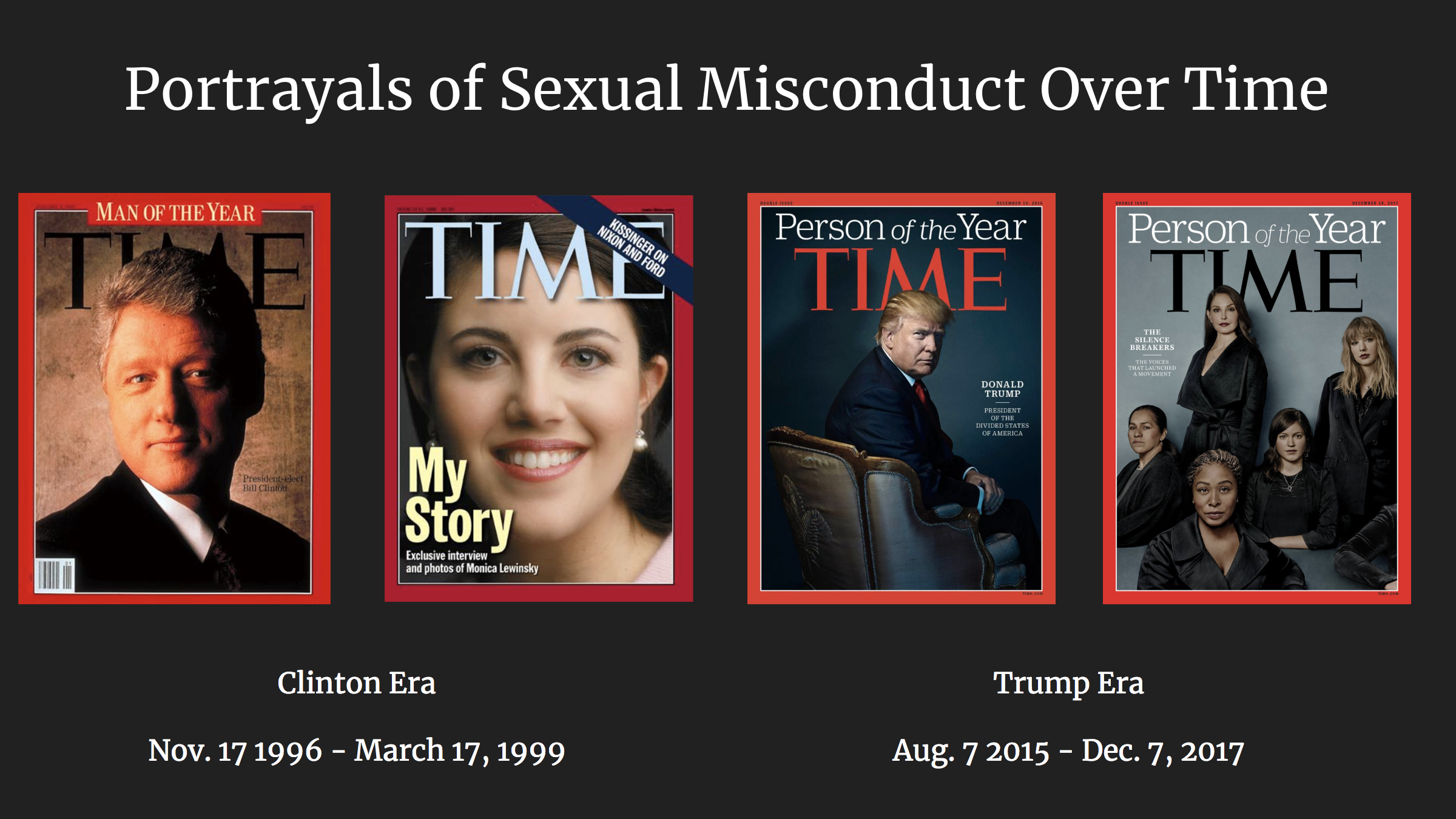Clinton, Trump, and Sexual Assault
Coverage of Survivors of Sexual Assault & Misconduct in Two Eras

In the midst of the #MeToo movement, we wondered how newspaper coverage of survivors of sexual assault and misconduct has changed over time.
To find out, we examined this issue in the New York Times and the Washington Post during two different eras: fourteen months before and after news of the Bill Clinton- Monica Lewinsky Scandal first broke in the Washington Post (November 17, 1996 to March 17, 1999) and fourteen months before and after the release of the Donald Trump Access Hollywood Tape (August 7, 2015 to December 7, 2017).
Because the more recent “Trump era” includes the beginning of the #MeToo movement, we expected there to be more articles written about sexual assault/misconduct than in the earlier “Clinton era.” This turned out to be true. In the Trump era, there were over 12,000 articles containing our sexual assault/misconduct search terms compared to approximately 7,500 in the Clinton era. We also expected there to be a spike in the number of articles written immediately after news broke about the Clinton-Lewinsky relationship and the release of the Trump tape. This also turned out to be true.
The most striking aspect of our research concerns how Clinton and Trump were covered as individuals in the wake of their respective “scandals.” We guessed that articles about sexual assault & misconduct that mentioned either Trump or Clinton in their respective eras would be more negative than articles that did not. However, the opposite is true.
In the Clinton era, articles that mentioned Clinton, while negative overall, were more positive when he was mentioned. The same is true for Trump in the Trump era. What is even more surprising is that the inclusion of Trump in an article in the Trump era had a more positive effect on the tone of articles than the inclusion of Clinton in the Clinton era.
While there is hardly any literature that delves into the media’s portrayal of recent high-profile alleged perpetrators of sexual assault, there are some (limited, often qualitative) studies about the media’s portrayals of Clinton. The prevailing scholarly view on the media’s portrayal of the Clinton/Lewinsky scandal is that the media favored President Clinton’s perspective more than Monica Lewinsky’s, thus casting the latter in a more negative light and the former in a more positive one. The fact that their relationship was portrayed as the “Lewinsky Scandal” is illustrative of the media’s negative portrayal of Lewinsky, who was consistently “mocked and disparaged,” for example, in the op-ed pages of the New York Times, as Tracy Everbach outlined in a 2017 study. Lewinsky (a high profile victim) simply did not have her side of the story represented as much as Clinton’s.
Many public opinion polls illustrate that even in the wake of several scandals, Clinton was still popular with the American public despite many voters saying that high moral character was an important attribute for a president to have, according to a 2003 study by Julie Yioutas and Ivana Segvic. Yioutas and Segvic suggest the reason for this can, in part, be tied to the way in which the media chose to portray the Clinton scandal. They argue the media focused more on the sexual aspects of Clinton’s relationship with Lewinsky, and less on how the president’s actions affected his ability to uphold the duties of his office. The media’s unrelenting attention to the sexual aspect of the relationship thus caused the American public to become immune to the scandal. Yioutas and Segvic argue that “the media’s attributes and heightened coverage negatively affected public salience.”
With this information in mind, and the changing culture around this issue, we believe this partly helps to explain why alleged perpetrators may be portrayed positively in articles about their own misconduct.
-Will DiGravio
Note: This research was conducted during the Winter of 2018, with Mira Chugh, Jamison Fletcher, and Erika Nakagawa.
Methodological note: We examined 19,790 articles that mentioned sexual assault, sexual misconduct, and related terms in the New York Times and Washington Post. Our analysis looked at articles published in two, separate, 28 month periods: November 17, 1996 to March 17, 1999 and August 7, 2015 to December 7, 2017. We use lexical sentiment analysis and regression analysis. For more information on our methods, please click here.